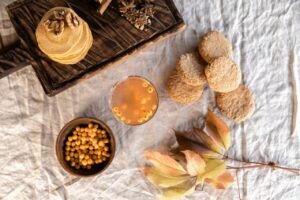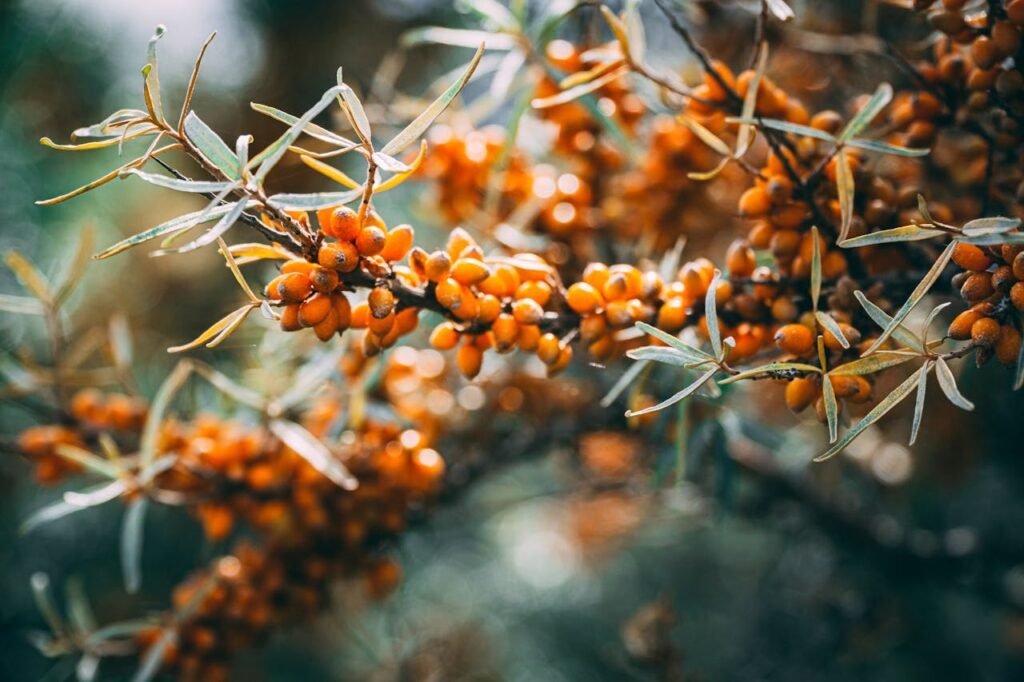Biological Information of Seabuckthorn
Seabuckthorn (Hippophae L.) has been included in the family Elaeagnaceae, order Elaeagnales but classification of this genus is still controversial. The genus name Hippophae was derived from two Latin words, “hippo” meaning “horse” and “phaos” meaning “to shine.”, In ancient Greece, leaves and young branches of the  plant were used as animal feed, especially for horses, to support weight gain and make their coats shiny.
plant were used as animal feed, especially for horses, to support weight gain and make their coats shiny.
They bears hard thorns originating from the stem. Thorniness varies from 1 to 5 thorns/cm2 of stem and the degree of thorniness differs among species. Plants are generally dioecious. Flowers are very small in size and yellowish in color. The leaves are usually small covered with silvery stellate scales which reflect sunshine and prevent moisture loss. Roots are characterized by the presence of root nodules containing a nitrogen fixing actinomycetes, Frankia.
It is also known as a “multipurpose-wonder plant” or “golden bush” because every part of the plant, such as fruit (berry), leaf, seed, stem, root, and thorn has some nutraceutical or medicinal value. Various phytochemicals like carbohydrates, vitamins, fatty acids, amino acids, organic acids, flavonoids, carotenoids, tocopherols, and mineral elements are found in the different parts of the plant. Seabuckthorn berries are reported to contain a very high content of vitamin C in addition to vitamin E and K. Juice is rich in amino acids, including essential amino acids.
Seabuckthorn, a traditional food source in Central Himalaya, is processed into various products like squash, syrup, jam, jellies, pickles, candies, pies, and dairy products. Its high vitamin C content provides health-promoting effects. Seabuckthorn fruit and seed oil are used in nutraceuticals and cosmetics due to its unique fatty acid composition.
It is an ancient plant with biological activity, is rich in nutritional active substances and has numerous health benefits. It is a pioneer tree species for soil improvement, wind and sand control, and water conservation. Sea buckthorn contains vitamins, carotenoids, polyphenols, fatty acids, and phytosterols, providing antioxidant, anticancer, anti-hyperlipidemic, anti-obesity, anti-inflammatory, and neuroprotective activities. It has potential in the human food industry.
BIOCHEMICAL OF SEABUCKTHORN
They contain over 190 bioactive compounds with various phytochemicals, vitamins, fatty acids, amino acids, organic acids, flavonoids, carotenoids, tocopherols, and mineral elements. Vitamin C is a high content in berries, along with vitamin E and K. Other vitamins include vitamin A and B. It’s juice is rich in amino acids, but there is a large variation in the content due to factors like geographical location, climate, harvesting time, extraction method, and processing. The berries also contain different mineral elements, which play a key role in metabolic processes.
Berries
Seabuckthorn berries, the most important part of the plant, are a rich source of bioactive compounds, including isorhamnetin, which has cardioprotective, hepatoprotective, antitumor, and anticancer activities. These berries are rich in carbohydrates, vitamins, essential fatty acids, amino acids, organic acids, and carotenoids, which are used in food additives, cosmetics, and nutraceuticals.
Leaves
Seabuckthorn leaves contain bioactive compounds, including flavonoids, which help treat diseases, normalize blood pressure, and boost immunity.
Bark
Seabuckthorn bark is used in Mongolian folk medicine for gastrointestinal symptoms, burn wound healing, blood purification, and antitumor activity. It also contains proanthocyanidins with health-promoting properties.
PHARMACOLOGICAL EFFECTS OF SEABUCKTHORN
Anticancer and Antitumor Activity
It’s leaves have been found to have antiproliferative effects on human acute myeloid leukemia cells, inhibiting tumor promotion and reducing carcinogen-induced papillomagenesis. The methanol extract of bark showed significant anticancer activity, reducing tumor volume, weight, viable cell count, and life span.
Antiinflammatory Activity
Leaf extract has been shown to have an antiinflammatory effect, suppressing lymphocyte proliferation and modifying the HMGB1 protein and potential in reducing inflammation.
Antimicrobial Activity
Plant is native to the tropical rainforest, has been found to possess significant antimicrobial properties against various bacterial and fungal cultures. The methanol extract of leaves, particularly the seed oil, has been found to be particularly effective against Staphylococcus aureus. The methanol extract also showed significant antimicrobial effect against various microbial isolates and antiviral activity against influenza virus strains A and B, herpes simplex type 1, adenovirus type 2, HIV-1, and gram-positive and negative microorganisms. Significant anti-dengue activity of leaf extract as shown in type-2 dengue virus infected blood-derived human macrophages, with a decrease and an increase in TNF-α and IFN-γ, respectively. The berry juice has also been found to have antibacterial properties against various microbial strains.
Hepatoprotective Ability
Seed oil and leaf extract have been shown to be hepatoprotective against liver diseases, particularly in CCl4-induced liver damage in rats. The phenolic rich fraction (PRF) of leaf extract, including gallic acid, myricetin, quercetin, kaempferol, and isorhamnetin, has been found to be protective against histopathological changes produced by CCl4. Oral administration of seed oil significantly reduced elevated levels of alanine aminotransferase, AST, ALP, TG, cholesterol, and malondialdehyde in the liver. Extract also reduced serum levels of laminin, hyaluronic acid, collagen types III, and IV, and total bile acid.
Radioprotective Effect
The radioprotective ability of berry extract has been found to be effective in inhibiting radiation-induced DNA damage and preventing cellular and mitochondrial free radical generation. The extract has shown potential in reducing DNA damage, both genomic and mitochondrial, with maximum protective effects. The radioprotective ability of berry extract can be attributed to its presence of polyphenolic flavonoids and tannins, as well as its radical scavenging activity.
Antiatherogenic and Cardioprotective Activity
Seabuckthorn, a rich source of antioxidants, unsaturated fatty acids, and flavonoids, has been shown to improve the function of the cardiovascular system. Seed oil has shown antiatherogenic and cardioprotective activity, and its flavonoids, such as isorhamnetin, have been shown to decrease serum triacylglycerol, HDL, and LDL cholesterol levels. Polyphenol extracts have shown protective potential against myocardial ischemia reperfusion injury (MIRI) by inhibiting autophagy. Total flavones of Hippophae rhamnoides (TFH) have also been shown to prevent thrombogenesis and protect against oxidized low-density lipoprotein (ox-LDL)-induced injury in endothelial cell lines.
Antiulcerogenic Effect of Seabuckthorn
Berries and pulp extract have been used to treat and prevent stomach ulcers in horses. The extract contains vitamin E and carotenoids, which have cumulative antioxidative actions and help to prevent mucosal irritation. Pulp oil has also been proven to speed up the healing process of acetic acid-induced stomach ulcers. The extract has also been demonstrated to reduce stomach tissue damage caused by the combination of methotrexate and indomethacin.
Effect on Platelet Aggregation
Pulp and seed oil reduced adenosine-5′-diphosphate-induced platelet aggregation, but had no effect on plasma lipids, fatty acid composition, or arachidonic acid-induced platelet aggregation. Berry juice (300mL/day for 8 weeks) reduced platelet aggregation when tested against aggregation agonists such as ADP, collagen, and arachidonic acid.
Hypoglycemic Effect
Extracts have been found to have a hypoglycemic effect on diabetic rats, lowering body weight, serum glucose, total cholesterol, and low-density lipoprotein cholesterol levels. Pulp also reduced blood glucose levels and thiobarbituric acid reactive substances (TBARS).Leaf powder supplemented diets also showed a significant hypoglycemic and antiinflammatory effect. Flavonoids also decreased blood glucose and lipid levels. Pure juice and l-quebrachitol enriched juices also showed improving glucose tolerance and pancreatic tissue integrity.
Antiaging Potential and Skin Whitening
Skin aging is a dermatologic change influenced by age and exposure to UVR. Fruit extract has potential for protecting against skin aging by regulating moisture content and MMP expression levels. Fruit extract has been found to decrease sebum secretion, improve acne severity, and improve barrier functions. Additionally, plant extracts have been used as skin whitening agents for hyperpigmentation and melasma treatment. These extracts have shown potential in treating skin issues like hyperpigmentation.
Eye diseases
Extract has a therapeutic role in reducing oxidative stress-induced cataracts by restoring levels of malonaldehyde, superoxide dismutase, and glutathione. It also protects against light-induced retinal degeneration by increasing antioxidant defense mechanisms, suppressing pro-inflammatory cytokines, and inhibiting retinal cell apoptosis.
Immunomodulatory
It has been found to possess significant immunomodulatory properties. Its alcoholic leaf and fruit extracts can arrest chromium-induced inhibition of lymphocyte proliferation, stimulate IL-2 and γ-IFN production, and inhibit chromium-induced decline in IL-2 and γ-IFN production. Flavones also stimulate IL-6 and TNF-α production, and protect against T-2 toxin-induced immunosuppression.
Neuroprotective Ability
Hydroalcoholic extract offers neuroprotective protection against peroxide, enhancing cell viability and preventing neurobiochemical changes induced by lead acetate.
Antiobesity
The ethanol extract of leaves prevents body weight gain and fat accumulation in the liver, while the leaf juice enhances gene expression of fatty acid beta-oxidation enzymes, increasing lipid metabolism and inhibiting fat deposition.
Antioxidant and Cytoprotective Ability
Extracts have been found to have a cytoprotective effect against oxidative stress, a major cause of clinical results. The extracts showing significant cytoprotective effects against oxidative damage and free radical generation. The extracts have been found to inhibit cytotoxicity, maintain antioxidant levels, and restore mitochondrial integrity. Additionally, flavones have shown cytoprotective activity against hydrogen peroxide and hypoxanthine-xanthine oxidase-induced damage to BHK-21 cell lines. The extracts have also been found to inhibit CCl4-induced toxicity and restore antioxidant status. The potential as a natural antioxidant agent against oxidative stress caused by thermally oxidized lipids.
Healing Property of Seabuckthorn
The extract has been found to effectively heal internal and external wounds, including mucosal injuries. It also increased antioxidants and decreased lipid peroxide levels in wound granulation tissues. This treatment is particularly beneficial for diabetic wounds.
Antistress and Adaptogenic Ability
Leaf extracts have been found to have adaptogenic properties. The maximum adaptogenic and antistress activity was observed at 100mg/kg body weight dose 30min before exposure to C-H-R stress. Leaf extract also curtails hypoxia-induced transvascular permeability by decreasing water content and fluorescein leakage in the lungs.
Conclusion
Seabuckthorn, an ancient plant with biological activity, is rich in nutritional active substances and has numerous health benefits.


